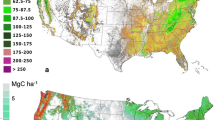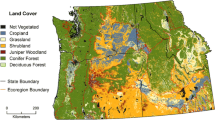Abstract
The landmark paper of Seiler and Crutzen (1980) clearly laid out the scientific rationale as to why the study of biomass burning was essential in terms of completely understanding greenhouse gases emissions from the land surface to the atmosphere. While this analysis fueled much of the fire and biomass burning-related research in the tropical biomes (forests and savannas), it turned scientific attention away from the boreal region, as one conclusion drawn from the Seiler and Crutzen analysis was that on a global scale, the amount of carbon released into the atmosphere was very small relative to other biomes. Recent research has shown that the Seiler and Crutzen estimates of carbon released into the atmosphere from fires in the boreal forests may be out by at least an order of magnitude. In addition, because fires consume organic soils which take thousands of years to form, biomass burning in the boreal forest may actually represent a direct net release of carbon to the atmosphere over intermediate time scales (hundreds of years). Finally, fires in boreal forests have significant impacts on the physical climate of the soil substrate in boreal forests, which in turn, affect soil respiration and plant growth. Thus, fires have important indirect effects on sequestration of atmospheric carbon in the boreal region.
In this paper, we review the overall short- and long-term effects that fire has on exchanges of carbon between the atmosphere and boreal forest ecosystems. Using examples from recent research in the boreal forests of Alaska and elsewhere, this paper addresses the following questions: (1) how much fire occurs in the boreal forest? (2) how much biomass is consumed during fires in the boreal forest and what types and what levels of greenhouse gases are released during these fires? (3) how much carbon was released during fires in the North American boreal forests from 1970 to present? (4) how do fires influence patterns of soil respiration? and (5) how do fires influence the patterns of forest succession?
Access this chapter
Tax calculation will be finalised at checkout
Purchases are for personal use only
Preview
Unable to display preview. Download preview PDF.
Similar content being viewed by others
References
Adams, P.C. and L.A. Viereck, 1997. Soil temperature and seasonal thaw — controls and interactions in floodplain stands along the Tanana River, interior Alaska. In Proceedings of the International Symposium on Physics, Chemistry, and Ecology of Seasonally Frozen Soils, Fairbanks, Alaska, June 10–12, 1997, 105–111.
Bonan, G.B. 1992. Soil temperature as an ecological factor in boreal forests, pp. 126–143 in H.H. Shugart, R. Leemans, and G.B. Bonan, editors. A Systems Analysis of the Global Boreal Forest, University Press, Cambridge, England.
Bonan, G.B. and K. Van Cleve. 1992. Soil temperature, nitrogen mineralization, and carbon source-sink relationships in boreal forests. Canadian Journal of Forest Research 22:629–639.
Kasischke, E.S., N.L. Christensen, Jr., and B.J. Stocks, 1995. Fire, Global warming and the mass balance of carbon in boreal forests. Ecological Applications 5: 437–451.
Kasischke, E.S., B.J. Stocks, K.P. O’Neill, N.H.F. French and L.L. Bourgeau-Chavez 1999a. Direct effects of fire on the boreal forest carbon budget, this volume.
Kasischke, E.S., K.P. O’Neill, N.N.H.F. French, L.L. Bourgeau-Chavez, and D. Richter, 1999b. The influence of fire on long-term patterns of forest succession in Alaskan boreal forests. in Fire, Climate Change and Carbon Cycling in the North American Boreal Forests, Kasischke, E.S., and B.J. Stocks (editors), Ecological Studies Series, Springer-Verlag, New York, (in press).
O’Neill, K.P.; Kasischke, E.S.; Richter, D.D.; Krasovic, V. 1997. Effects of fire on temperature, moisture and CO2 emissions from soils near Tok, Alaska. In Proceedings of the International Symposium on Physics, Chemistry, and Ecology of Seasonally Froze Soils, Fairbanks, Alaska, June 10–12, 1997, 295–303.
Richter, D., E.S. Kasischke, and K.P. O’Neill, 1999. Stimulation of soil respiration in burned black spruce (Picea mariana L.) forest ecosystems, in Fire, Climate Change and Carbon Cycling in the North American Boreal Forests, Kasischke, E.S., and B.J. Stocks (editors), Ecological Studies Series, Springer-Verlag, New York, (in press).
Schlentner, R.E. and K. Van Cleve. 1985. Relationships between CO2 evolution from soil, substrate temperature, and substrate moisture in four mature forest types in interior Alaska. Canadian Journal of Forest Research 15:97–106.
Smith, T.M. and H.H. Shugart 1993. The transient response of carbon storage to a perturbed climate. Nature 361: 563–566.
Stocks, M.A. Fosberg, T.J. Lynham, L. Mearns, B.M. Wotton, Q. Yang, J-Z. Jin, K. Lawrence, G.R. Hartley, J.A. Mason, and D.W. McKenney 1998. Climate change and forest fire potential in Russian and Canadian boreal forests. Climatic Change 38: 1–13.
Van Cleve, K. and L. Viereck 1981. Forest succession in relation to nutrient cycling in the boreal forest of Alaska. Pages 184–211 in D.C. West, H.H. Shugart and D.B. Botkin, editors. Forest Succession, Concepts and Application. Springer-Verlag, New York.
Van Cleve, K., C.T. Dyrness, L.A. Viereck, J. Fox, F.S. Chapin III, and W. Oeche 1983a. Taiga ecosystems in interior Alaska. Bioscience 33: 39–44.
Van Cleve, K., L. Oliver, R. Schlentner, L.A. Viereck, and C.T. Dyrness, 1983b. Productivity and nutrient cycling in taiga forest ecosystems. Canadian Journal of Forest Research 13: 747–766.
Van Wagner, C.E. 1978. Age-class distribution and the forest fire cycle. Canadian Journal of Forest Research 8: 220–227.
Viereck, L.A., 1983. The effects of fire in black spruce ecosystems in Alaska and northern Canada, in The Role of Fire in Northern Circumpolar Ecosystems, Wein, R.W., and D.A. Mac Lean, editors, John Wiley and Sons, New York, 322 pp. 201–220.
Author information
Authors and Affiliations
Editor information
Editors and Affiliations
Rights and permissions
Copyright information
© 2000 Kluwer Academic Publishers
About this chapter
Cite this chapter
Kasischke, E.S., O’Neill, K., Bourgeau-Chavez, L.L., French, N.H.F. (2000). Indirect and Long-Term Effects of Fire on the Boreal Forest Carbon Budget. In: Innes, J.L., Beniston, M., Verstraete, M.M. (eds) Biomass Burning and Its Inter-Relationships with the Climate System. Advances in Global Change Research, vol 3. Springer, Dordrecht. https://doi.org/10.1007/0-306-47959-1_15
Download citation
DOI: https://doi.org/10.1007/0-306-47959-1_15
Publisher Name: Springer, Dordrecht
Print ISBN: 978-90-481-5375-6
Online ISBN: 978-0-306-47959-5
eBook Packages: Springer Book Archive




